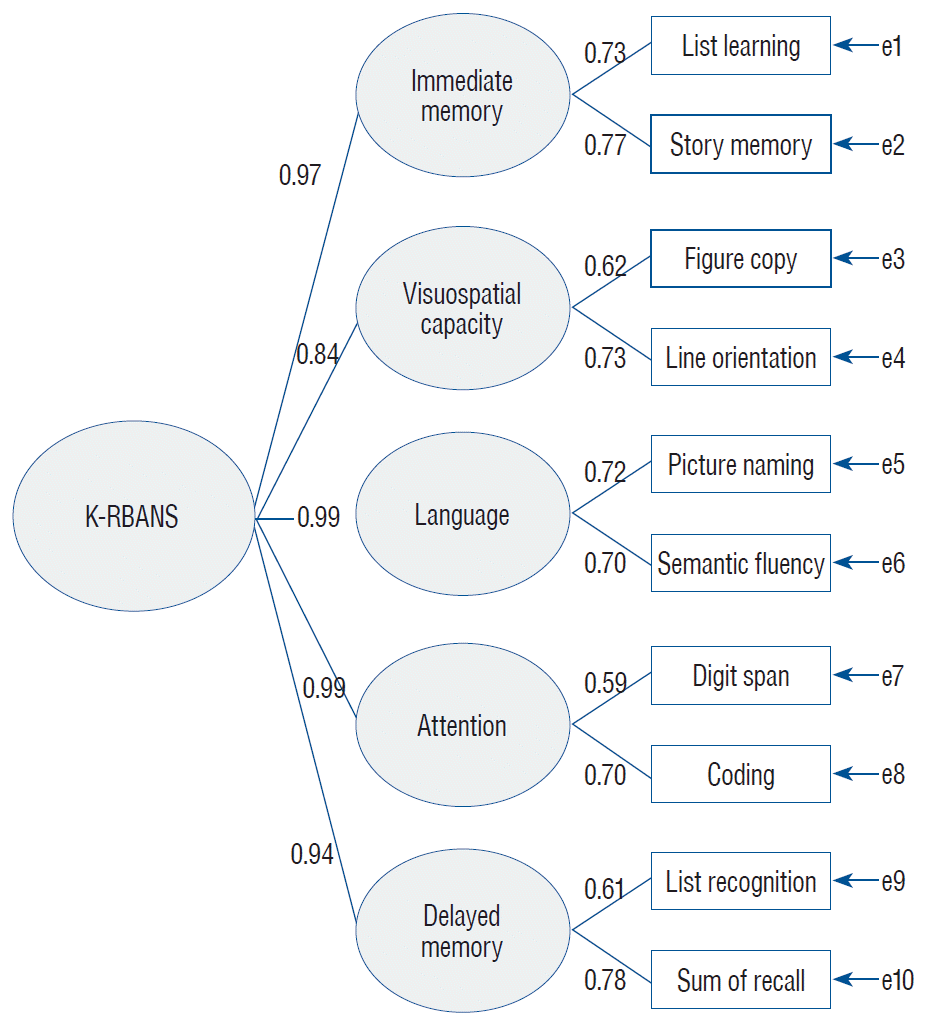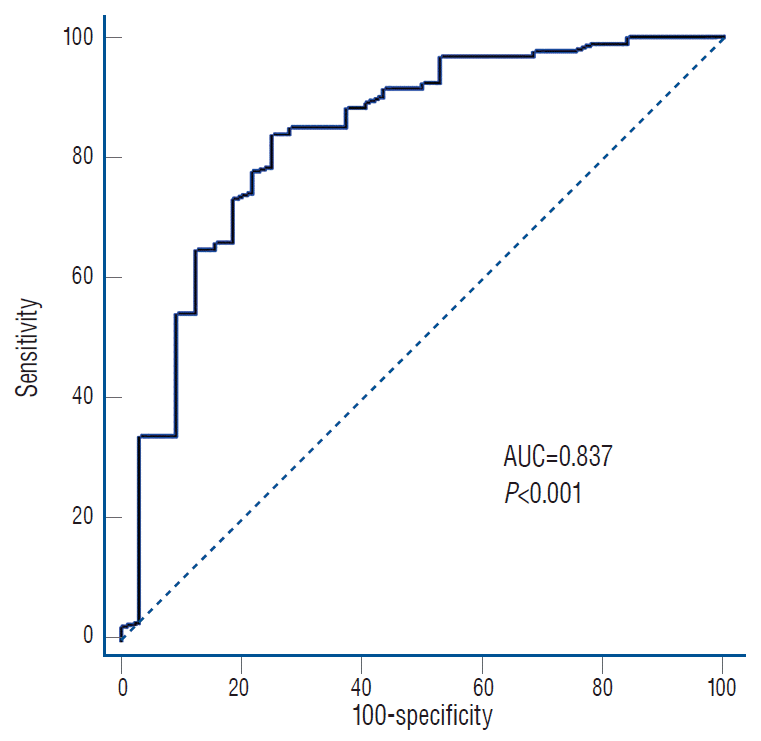1. Arbuckle J. Amos 25.0: computer program [CD-ROM]. Chicago: IBM SPSS;2017.
2. Berg L, Miller JP, Storandt M, Duchek J, Morris JC, Rubin EH, et al. Mild senile dementia of the Alzheimer type: 2. Longitudinal assessment. Ann Neurol. 23:477–484. 1988.

3. Bryant FB, Yarnold PR. Principal-components analysis and exploratory and confirmatory factor analysis. In : Grimm LG, Yarnold PR, editors. Reading an Understanding Multivariate Statistics. Washington DC: American Psychological Association;1995. p. 99–136.
4. Byrne BM. Factor analytic models: viewing the structure of an assessment instrument from three perspectives. J Pers Assess. 85:17–32. 2005.

5. Cheng Y, Wu W, Wang J, Feng W, Wu X, Li C. Reliability and validity of the repeatable battery for the assessment of neuropsychological status in community-dwelling elderly. Arch Med Sci. 7:850–857. 2011.
6. De la Torre GG, Suárez-Llorens A, Caballero FJ, Ramallo MA, Randolph C, Lleó A, et al. Norms and reliability for the Spanish version of the repeatable battery for the assessment of neuropsychological status (RBANS) form A. J Clin Exp Neuropsychol. 36:1023–1030. 2014.

7. Emmert N, Schwarz L, Vander Wal J, Gfeller J. RBANS factor structure in older adults with suspected cognitive impairment: evidence for a 5-factor structure. Appl Neuropsychol Adult. 25:38–50. 2018.

8. Folstein MF, Folstein SE, McHugh PR. "Mini-mental state". A practical method for grading the cognitive state of patients for the clinician. J Psychiatr Res. 12:189–198. 1975.
9. Gregoire J. ITC guidelines for translating and adapting tests. Int J Test. 18:101–134. 2018.
10. Holden HM, Milano NJ, Horner MD. Five-factor structure of the RBANS is supported in an Alzheimer's disease sample: implications for validation of neuropsychological assessment instruments. Appl Neuropsychol Adult. 27:232–242. 2020.

11. Hooper D, Coughlan J, Mullen MR. Structural equation modelling: guidelines for determining model fit. Electron J Bus Res Methods. 6:53–60. 2008.
12. Hughes CP, Berg L, Danziger WL, Coben LA, Martin RL. A new clinical scale for the staging of dementia. Br J psychiatry. 140:566–572. 1982.

13. Hwang S, Kim J, Park K, Chey J, Hong S. Korean Wechsler Adult Intelligence Scale-IV. ed 4. Daegu: Korea Psychology;2012.
14. Kang Y, Na DL, Hahn S. A validity study on the Korean mini-mental state examination (K-MMSE) in dementia patients. J Korean Neurol Assoc. 15:300–308. 1997.
15. Kang Y, Na DL, Hahn S. Seoul Neuropsychological Screening Battery. Incheon: Human Brain Research & Consulting Co.;2003.
16. Kang YW, Jahng SM, Na DR. Seoul Neuropsychological Screening Battery (SNSB-II). ed 2. Incheon: Human Brain Research & Consulting;2012.
17. Kaufman AS. Manual for the Kaufman Assessment Battery for Children (K-ABC-II). Circle Pines: AGS;2004.
18. Kim JS, Kim OL, Seo WS, Koo BH, Joo Y, Bai DS. Memory dysfunctions after mild and moderate traumatic brain injury : comparison between patients with and without frontal lobe injury. J Korean Neurosurg Soc. 46:459–467. 2009.

19. Kwak HW, Kim JY, Park JO, Park HG, Bai DS, Im JM, et al. Korean Version of Repeatable Battery for the Assessment of Neuropsychological Status: Update. Daegu: Korea Psychology Co.;2018.
20. Lee JH, Lee KU, Lee DY, Kim KW, Jhoo JH, Kim JH, et al. Development of the Korean version of the consortium to establish a registry for alzheimer's disease assessment packet (CERAD-K): clinical and neuropsychological assessment batteries. J Gerontol B Psychol Sci Soc Sci. 57:P47–P53. 2002.

21. Lee JY, Lee DW, Cho SJ, Na DL, Jeon HJ, Kim SK, et al. Brief screening for mild cognitive impairment in elderly outpatient clinic: validation of the Korean version of the Montreal Cognitive Assessment. J Geriatr Psychiatry Neurol. 21:104–110. 2008.

22. Lezak MD, Howieson DB, Bigler ED, Tranel D. Neuropsychological Assessment. ed 5. New York: Oxford University Press;2012. p. 3–14.
23. Loughan AR, Braun SE, Lanoye A. Repeatable battery for the assessment of neuropsychological status (RBANS): preliminary utility in adult neuro-oncology. Neurooncol Pract. 6:289–296. 2019.

24. Malda M, Van De Vijver FJR, Srinivasan K, Transler C, Sukumar P, Rao K. Adapting a cognitive test for a different culture: an illustration of qualitative procedures. Psychol Sci Q. 50:451–468. 2008.
25. Mattis S. Dementia Rating Scale. Odessa: Psychological Assessment Resources;1988.
26. McKay C, Casey JE, Wertheimer J, Fichtenberg NL. Reliability and validity of the RBANS in a traumatic brain injured sample. Arch Clin Neuropsychol. 22:91–98. 2007.

27. Moon SB. Manual for Korean K-ABC-II. Seoul: Hakjisa;2014.
28. Morris JC. Current vision and scoring rules The Clinical Dementia Rating (CDR). Neurology. 43:2412–2414. 1993.
29. Randolph C. RBANS manual. San Antonio: The Psychological Corporation;1988.

30. Randolph C. RBANS update manual. San Antonio: The Psychological Corporation;2012.
31. Randolph C, Hilsabeck R, Kato A, Kharbanda P, Li YY, Mapelli D, et al. Neuropsychological assessment of hepatic encephalopathy: ISHEN practice guidelines. Liver Int. 29:629–635. 2009.

32. Randolph C, Tierney MC, Mohr E, Chase TN. The repeatable battery for the assessment of neuropsychological status (RBANS): preliminary clinical validity. J Clin Exp Neuropsychol. 20:310–319. 1998.

33. Suraweera C, Anandakumar D, Dahanayake D, Subendran M, Perera UT, Hanwella R, et al. Validation of the Sinhala version of the repeatable battery for assessment of neuropsychological status (RBANS). Ceylon Med J. 61:167–170. 2016.

34. Swets JA. Measuring the accuracy of diagnostic systems. Science. 240:1285–1293. 1988.

35. Torrence ND, John SE, Gavett BE, O'Bryant SE. An empirical comparison of competing factor structures for the repeatable battery for the assessment of neuropsychological status: a project FRONTIER study. Arch Clin Neuropsychol. 31:88–96. 2016.

36. Weclser D. Wechsler Adult Intelligence Scale. ed 4. Bloomington: Pearson;2008.
37. Yamashima T, Yoshida M, Kumahashi K, Matsui M, Koshino Y, Higashima M, et al. The Japanese version of RBANS (repeatable battery for the assessment of neuropsychological status). No To Shinkei. 54:463–471. 2002.






 PDF
PDF Citation
Citation Print
Print



 XML Download
XML Download